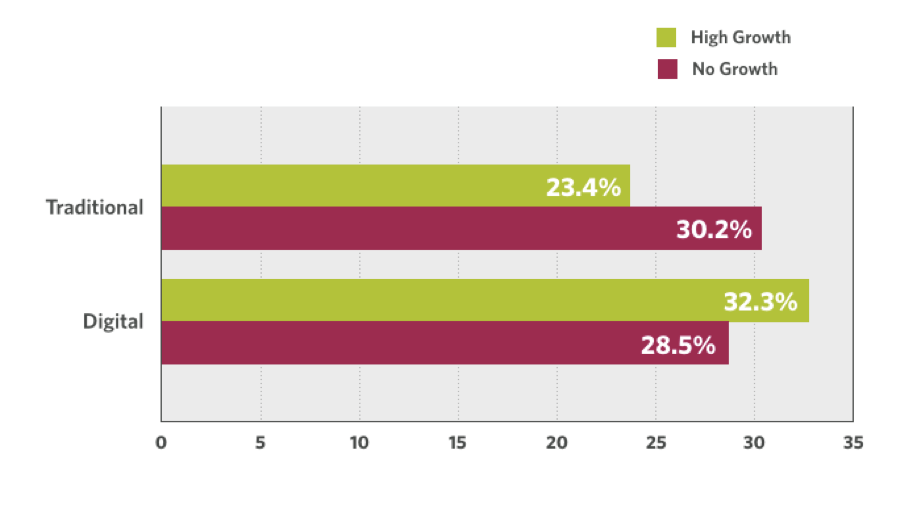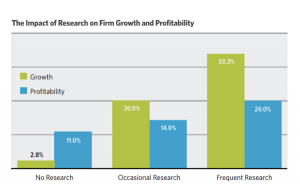Some professional services firms have a dedicated marketing team.
Others don’t, relying instead on a combination of internal and outsourced resources. Either way, a firm’s
leadershiphas to produce a comprehensive marketing plan to achieve future growth and profitability.Of course, today when we say “marketing,” we are talking about a blend of traditional with digital techniques, with the balance of the emphasis on the latter. Many leaders find it challenging to build a full marketing strategy with just the right balance – and even more challenging to train teams on the ever changing landscape around digital. Here’s the good news: there are a few fundamental rules you can use to make better
marketingdecisions and build a strategy that outperforms average firms.So here they are: the five things you need to know to
developa marketing game plan that works and ensure your digital marketing training is impactful.
1. High-growth firms spend more on digital marketing
In our latest research into the factors that separate high-growth firms from their no-growth counterparts, we found that high-growth firms consistently spend more on
digital marketing— and less on traditional techniques. On average, high-growth firms invest 13% more of their overall marketing budget on digital strategies.

That’s not to suggest that high-growth firms ignore traditional marketing altogether. Speaking engagements, partnership marketing and networking are all part of the marketing mix that catapults these firms to greater growth and profitability. The secret is in the mix. High-growth firms recognize that most traditional marketing strategies have a digital counterpart. And the digital approaches often cost less (building a lead-generating website, for example, can cost less than a single conference sponsorship) and allow more targeted interactions. You can’t control who sits in the seats during your keynote address, but by ensuring your team has the right digital marketing training, you can use SEO, offer strategies and online thought leadership to influence who comes to your website.Which brings me to my next point…
2. High-growth firms invest in a cohesive system of techniques and tools
As you can see in the chart above, which compares spending on traditional versus digital strategies, even firms that aren’t growing invest in digital. However, our research shows that high-growth firms see 35% greater impact from their digital marketing techniques than do their no-growth peers.What gives? Is it the particular strategies they choose to employ? That certainly accounts for at least part of the equation. But the secret to getting more ROI from marketing, whether digital OR traditional, is to build a coordinated system – emphasis on “system” – of tools and techniques. In this systematic approach, each technique both supports and benefits from the others.For example, many firms produce a blog. But without systematic keyword, link-building and optimization strategies to help your audience find the blog in the first place, the strategy will stall from the start. Without enticing offers in place, your readers won’t be encouraged to take the next step. And without a clear engagement strategy to turn readers into clients, you won’t get any meaningful return on your investment.We hear it all the time. “I’ve blogged consistently over the last 2 years and have never received a bite.” That’s because either your strategy or execution is flawed, or both. How do you correct this problem? You’ll need to train your team understand the dynamics of digital marketing — then they can build a system that delivers consistent results.The illustration below is an example of a cohesive system. Notice that at each stage there is a system of tools and techniques specifically chosen to entice people to take another step down the pipeline. It’s repeated engagement — not the power of any one tool — that builds trust over time and turns visitors into clients.
 3. High-growth firms treat their websites as one of their most important business development assets
3. High-growth firms treat their websites as one of their most important business development assets
At Hinge, we spend a lot of time analyzing, deconstructing and rebuilding websites. Why? In the world of professional services, a website can — and should — be one of your highest performing business development assets. Here are a few insights from our research:
80% of professional services buyers check out your website. Fair or not, this is often the first place we’re judged and vetted by our buyers. 44% of professional services buyers rule out a firm because they couldn’t understand how the firm could help them. If your website is the first line of defense, then the structure, messaging, imagery and thought leadership better quickly convey that you solve your prospects’ problems — or you risk leaving a lot of business on the table. 30% of professional services buyers rule out a firm because of an unimpressive website. Ouch! Painful, but true. And it’s why high growth firms place the same importance on their websites as they do on their flesh-and-blood business development team. 4. Expertise matters
We know from our research that
expertise is one of the top criteria buyers use when evaluating firms. But how do they judge a firm’s expertise before they’ve worked with them? Slick brochures and pitch decks aren’t going to cut it. That’s where blogs, webinars, books and articles come in. The former sell, the latter educate. Taking a thought-leadership, education-first approach allows potential buyers to sample your expertise before taking the plunge. As they say, “a little knowledge goes a long way.”And what about referrals? We already learned from our research (see #3 above) the extent to which referrals will judge firms on their website alone.What factors increase the probability of getting those coveted referrals to actually take the next step and call? Our research shows that what we refer to as “Visible Expertise” trumps other factors. Visible Expertise refers to the simple notion of making your expertise well known in the marketplace. But not just any expertise. Expertise that matters to your audience. Expertise that can solve their problems.
What Factors Increase the Probability of Referrals?

5. High-growth firms know their audience — through their audience’s lens
If you know Hinge, you know our obsession with research. Time and again, our own research shows a strong correlation between firms that conduct systematic research on their target audience and exceptional growth and profitability.

Why is this? When you conduct market research on a regular basis, you build an understanding of your world as your audience sees it.Without the benefit of research, firms run the very real risk of introducing bias and an internal agenda into their growth strategy. They become blind to the to their audience’s evolving challenges and needs. Clients and prospects see and experience things differently than we do, and a good strategy will go out of its way to overcome that limitation.Research also reduces the risk of allocating your budget to the wrong set of tools and techniques. Data can be a powerful compass as you try to find your way through the fog of indecision — and allocate your marketing budget to activities your prospective clients actually care about. Without data, you’re just guessing.2017 is around the corner. So now is the perfect time to adjust course and ensure your firm is following these five marketing rules. Of course, to compete in an online world, your marketing staff will need up-to-date knowledge and skills. That’s why forward-thinking organizations provide ongoing digital marketing training for key personnel, including executives in charge of marketing. High-growth firms do it. Shouldn’t you?
 That’s not to suggest that high-growth firms ignore traditional marketing altogether. Speaking engagements, partnership marketing and networking are all part of the marketing mix that catapults these firms to greater growth and profitability. The secret is in the mix. High-growth firms recognize that most traditional marketing strategies have a digital counterpart. And the digital approaches often cost less (building a lead-generating website, for example, can cost less than a single conference sponsorship) and allow more targeted interactions. You can’t control who sits in the seats during your keynote address, but by ensuring your team has the right digital marketing training, you can use SEO, offer strategies and online thought leadership to influence who comes to your website.Which brings me to my next point…
That’s not to suggest that high-growth firms ignore traditional marketing altogether. Speaking engagements, partnership marketing and networking are all part of the marketing mix that catapults these firms to greater growth and profitability. The secret is in the mix. High-growth firms recognize that most traditional marketing strategies have a digital counterpart. And the digital approaches often cost less (building a lead-generating website, for example, can cost less than a single conference sponsorship) and allow more targeted interactions. You can’t control who sits in the seats during your keynote address, but by ensuring your team has the right digital marketing training, you can use SEO, offer strategies and online thought leadership to influence who comes to your website.Which brings me to my next point… 3. High-growth firms treat their websites as one of their most important business development assets
3. High-growth firms treat their websites as one of their most important business development assets 
 Why is this? When you conduct market research on a regular basis, you build an understanding of your world as your audience sees it.Without the benefit of research, firms run the very real risk of introducing bias and an internal agenda into their growth strategy. They become blind to the to their audience’s evolving challenges and needs. Clients and prospects see and experience things differently than we do, and a good strategy will go out of its way to overcome that limitation.Research also reduces the risk of allocating your budget to the wrong set of tools and techniques. Data can be a powerful compass as you try to find your way through the fog of indecision — and allocate your marketing budget to activities your prospective clients actually care about. Without data, you’re just guessing.2017 is around the corner. So now is the perfect time to adjust course and ensure your firm is following these five marketing rules. Of course, to compete in an online world, your marketing staff will need up-to-date knowledge and skills. That’s why forward-thinking organizations provide ongoing digital marketing training for key personnel, including executives in charge of marketing. High-growth firms do it. Shouldn’t you?
Why is this? When you conduct market research on a regular basis, you build an understanding of your world as your audience sees it.Without the benefit of research, firms run the very real risk of introducing bias and an internal agenda into their growth strategy. They become blind to the to their audience’s evolving challenges and needs. Clients and prospects see and experience things differently than we do, and a good strategy will go out of its way to overcome that limitation.Research also reduces the risk of allocating your budget to the wrong set of tools and techniques. Data can be a powerful compass as you try to find your way through the fog of indecision — and allocate your marketing budget to activities your prospective clients actually care about. Without data, you’re just guessing.2017 is around the corner. So now is the perfect time to adjust course and ensure your firm is following these five marketing rules. Of course, to compete in an online world, your marketing staff will need up-to-date knowledge and skills. That’s why forward-thinking organizations provide ongoing digital marketing training for key personnel, including executives in charge of marketing. High-growth firms do it. Shouldn’t you?


